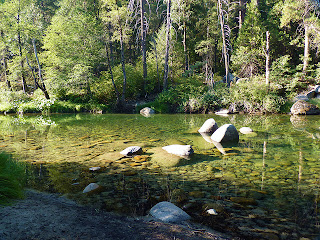 |
| South Fork of the Merced River |
Dear Wawona Community:
This winter and spring have been exceptionally mild with regard to rain and snowfall. To date, 2012 is set to go down as one of the 10 driest years on record for Yosemite National Park. Because of this, water levels measured in the rivers and streams are exceptionally low for June. In fact, current data shows that water levels on the South Fork Merced River, for example, are dropping quickly and there is no significant precipitation forecasted in the near future.
Without significant precipitation in the upcoming days and weeks, the Tuolumne and South Fork Merced Rivers will drop to levels where it will be necessary to implement water conservation plans for the residents and visitors to Tuolumne Meadows and Wawona. Water conservation measures are mandatory when flow rates drop below 6 cubic feet per second (CFS). As of June 22, the South Fork Merced River was measured at 17 CFS, and as the chart above shows, hydrologic modeling indicates that Wawona will need to implement conservation procedures in early July. Further, without significant rainfall, these levels will continue to drop and each river will likely reach critical levels by late July. Critical levels are reached when demand for water exceeds the supply which is at 2 CFS.
In order for Yosemite National Park to meet the domestic water needs of Wawona and Tuolumne Meadows, water from Yosemite Valley and the park’s South Entrance will need to be transported to the Wawona Water Treatment Plant daily. In Tuolumne Meadows, the water supply is augmented by drawing water from the main stem of the Tuolumne River. Historically, we have not had to implement water conservation efforts in Tuolumne Meadows, so we will all learn how successful our conservation measures actually work. What is important is that the amount of water to be transported and diverted will depend upon the success of the conservation efforts in each community.
Attentive conservation measures, therefore, are our best opportunity to ensure that water is available where needed for safety and health purposes, as well as protection of park resources. We ask that you consider your water consumption in the coming days and look for ways to conserve it. In the coming days and weeks, we will continue to share more information about the water levels and conservation practices.
We thank you for attention and support as we all address this important community and preservation issue. Through our combined efforts, we can work to maintain adequate domestic water while still preserving the ecosystems of Yosemite National Park.
Don Neubacher, Superintendent


